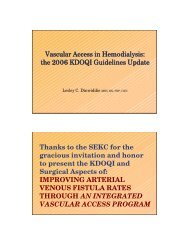Cannulation Camp
Cannulation Camp - Network 6
Cannulation Camp - Network 6
- No tags were found...
You also want an ePaper? Increase the reach of your titles
YUMPU automatically turns print PDFs into web optimized ePapers that Google loves.
<strong>Cannulation</strong> <strong>Camp</strong>Leighann Sauls RN CDNDebra Evans RN BSNSoutheastern Kidney CouncilESRD Network 6
Objectives• Define AVF Maturation• Describe the Mature AV Fistula• Define the Rule of 6• Define the “Best Tool” for Assessment ofthe AVF• Define the <strong>Cannulation</strong> Rating System• Define Wet Stick• Discuss <strong>Cannulation</strong> Techniques
Do you know this person?
Fistula Maturation• Definition: Process by which a fistula becomessuitable for cannulation• Develops:– adequate flow– wall thickness– diameterNational Kidney Foundation. Am J Kidney Dis. 2006;48(suppl 1):S1-S322.
A Mature Fistula• Vessel diameter must be 4–6mm• Vessel walls should toughen and be firmto the touch• There should be no prominent collateralveins
Clinical Clarification• The fistula should be examined regularlyfollowing surgery.• At 2 weeks post surgery, the fistula shouldbe evaluated specifically fornonmaturation.ti
During AVF Maturation Process• Look, listen, and feel the new AVF at everydialysis treatmentUse Your:EyesEarsFingertips
During AVF Maturation Process• After the scar heals, begin assessing AVFusing a “gentle” tourniquet placed high inthe axilla area• Instruct patient to start access exercisesafter healing (check with surgeon first)• Document patient education as well ascondition and maturation of the AVF
TourniquetPhoto courtesy of J. Holland
Clinical Clarification• Several studies suggest that performing accessexercises after surgery may contribute to thedevelopment of the fistula. 1-3• However, it is important to note that exercisealone will not turn a poor fistula into a good,functional fistula.• At 2- 4 weeks post surgery, the fistula should beevaluated specifically for nonmaturation.1. Rus RR, et al. Hemodialysis Int. 2005;9:275-280.2. Leaf DA, et al. Am J Med Sci. 2003;325:115-119.3. Oder TF, et al. ASAIO J. 2003;48:554-555.
Post-Op Follow-up• Communicate assessment findings withaccess team, including surgeon• Check maturity progress every session• Assure evaluation by surgeon 2 weekspost-op– Intervene if there is no progress at 4 weeks orAVF is not mature and ready for cannulationat 6–8 weeks
During Maturation• Look for the healing process andmaturation of the vessel• Listen for continuous low-pitched bruit• Feel for strong thrill at arterial anastomosis• Document fistula maturation, patienteducationwww.fistulafirst.org
Rule of 6’s 6s• Rule of 6’s: 6s: In general, a mature fistula should:– Be a minimum of 6 mm in diameter withdiscernible margins when a tourniquet is inplace– Be less than 6 mm deep– Have a blood flow greater than 600 ml/minduring access flow monitoring– Be evaluated for non-maturation at 2 weeksafter surgical creation to ensure that it willmeet the above criteria
Documentation• Document• Document• Document• What you see• What you hear• What you feel• Patient t education performed
Is This New AVF Matureand Ready for <strong>Cannulation</strong>?Photo courtesy of J. Rowland
Is This AVF Mature and Readyfor the Initial <strong>Cannulation</strong>?a) Vein looks large enoughb) Vein feels prominent and straightc) Vein has a strong thrill and good bruitd) Physician ordere) All of the above
Fistula Maturation• What diagnostic tools or techniques canbe used to determine if an AVF is readyfor cannulation?
Diagnostic Tools/Techniques toDetermine If an AVF Is Ready• Physical exam by the:– Nephrologist– PCT– Nephrology nurse– Surgeon• Duplex Doppler study• Angiogram (fistulogram)
Maturing FistulaPhysical Exam• Firm, no longer mushy• Vessel wall thickening• Vessel diameter enlargement (to 4–6 mm)• Absence of prominent collateral veinsIf in doubt, “Just Say No”
During Physical Examination• Assess AVF for complications• Thrombosis caused by:– Stenosis– Infection– Steal syndrome– Aneurysms• Thrombosis represents the Potential lossof the access.
Best Tool/Technique?Physical Exam!• Look, listen, and feel the new AVF at everydialysis treatmentUse Your:EyesEarsFingertips
InspectionLook for: Changes compared to opposite extremity Skin color/circulation Skin integrity Edema Drainage Vessel size/cannulation areas Aneurysm Hematoma Bruising
Look for ComplicationsChanges in Access• Redness• Drainage Infection• Abscess• <strong>Cannulation</strong> sites • Distal Areas of Access• AneurysmsExtremity• Hands/Feet:Changes in AccessExtremity• Skin color• Edema• Small blueor purpleveins• Hematoma• BruisingColdorPainfulNumbvein • Fingers/Toes:t i DiscoloredCentraloutflowstenosisStealsyndrome
Signs and Symptoms ofComplications• Differences in extremities– Edema or changes in skin color = stenosis or infection– Temperature Changes• Warmth of extremity – infection?• Coldness of extremity – steal syndrome?– Access• Redness, drainage, abscess = infection• Aneurysms– Access extremitiese t es• Small, blue/purple veins = stenosis• Discolored fingers = steal syndrome
Observe Access Extremityfor Stenosis• Before the patient has needles inserted– Make a fist with access arm dependent;observe vein filling– Raise access arm; entire AVF should flatten/collapse if no stenosis/obstruction• If a segment of the AVF has not collapsed,stenosis is located at junction betweencollapsed and noncollapsed segment• Instruct t patient t to perform this at home
Thrill for Stenosis• Abrupt change or loss• Pulse-likeNarrowing of vein = stenosis
Infection• Lower rate with AVF compared with otheraccess types 1,2• Staphylococcus aureus the most commonpathogen 2• Patients and dialysis personnel have highrates of Staphylococcus on skin 3• Handwashing before, after, and betweenpatients is critical 41. National Kidney Foundation. Am J Kidney Dis. 2006;48(suppl 1):S1-S322.2. Dialysis Outcomes and Practice Patterns Study (DOPPS) Guidelines. Available at: www.dopps.org.3. Kirmani N, et al. Arch Intern Med. 1978;138:1657-1659.4. Boyce JM, Pittet D. MMWR 2002;51(RR16):1-44.
Steal Syndrome• Caused by a shortage of blood to the hand• Rare but can be serious• Occurs in approximately 5% of vascular access patients• Occurs mostly those with diabetes and peripheralvascular disease.• Regularly evaluate sensory-motor changes to hand andcondition of skin, especially in diabetic patients• Steal symptoms may improve due to the development ofcollateral circulation
“Claw Hand” ContractureFrom Steal SyndromePhoto courtesy of J. Holland
Is Steal Syndrome Serious?• Steal/ischemia may lead to loss of function andamputation if not recognized and treated quickly• Necrotic tissue cannot be “fixed”—it it must beremoved• Steal/ischemia places patients at risk forinfection• Infection increases their risk for hospitalization• Hospitalization increases their risk for death!
Aneurysm• Localized ballooningPhoto courtesy of D. Brouwer
Aneurysms• Caused by sticking needles in the samegeneral area• Aneurysm can also result from stenosisbeyond the aneurysm, causing elevatedback pressure
PalpationTemperature Change Warmth = possible infection Cold = decreased blood supplyThrill Palpation can be started t at the anastomosis Thrill diminishes evenly along access length Change can be felt at the site of a stenosis;becomes “pulse-like” at the site of a stenosis Stenosis may also be identified as a narrowedarea
PalpationFeel for Size, Depth, Diameter, andStraightness of AVF• Feel the entire AVF from arterialanastomosis all the way up the vein• Evaluate for possible cannulation sites =superficial, straight vein section withadequate and consistent vein diameter
AuscultationListen for the Nature of the BruitPhoto courtesy of J. Holland
AuscultationListen for Bruit• Listen to entire access every treatment• Note changes in sound characteristics (bruit):– A well-functioning fistula should have acontinuous, machinery-like bruit on auscultation– An obstructed (stenotic) fistula may have adiscontinuous and pulse-like bruit rather than acontinuous one—and also may be louder andhigh-pitched or “whistling”– Louder at stenosis than at anastomosis
Requirements for <strong>Cannulation</strong>• Physician order• Experienced, qualified staff person• Tourniquet
Fact• Experienced dialysis staff have an 80%success rate for identifying fistula maturity.Robbin ML, et al. Radiology. 2002;225:59-64.
Best Tool/Technique?Physical Exam!• Look, listen, and feel the new AVF at everydialysis treatmentUse Your:EyesEarsFingertips
<strong>Cannulation</strong>Protocols<strong>Cannulation</strong> Rating SystemWet StickTechniques
THE RULES
Protocol for AVF <strong>Cannulation</strong>• <strong>Cannulation</strong> guidelines– New AVF– Mature AVF– Unsuccessful cannulations• Detailed instructions for complications –including needed interventions• Definition of successful cannulation• Catheter removal
<strong>Cannulation</strong> of a New AVF• A “New AVF <strong>Cannulation</strong> Protocol” shouldbe developed by the entire healthcareteam, including access surgeon andinterventional nephrologist/radiologist
Implementing a Unit-SpecificProtocol for “New AVF <strong>Cannulation</strong>”• Define:– Successful cannulation– Documentation guidelines for all cannulationprocedures– Unsuccessful cannulation• Detailed instructions to follow for anyanticipated complications for both staffand patients– Example: If an infiltration occurs on firstattempt, should a second attempt be made…and when?
Recommended Use of aCannulator Rating System• Combine cannulation knowledge and skillinto a competency-based assessmentrating system• Enhance continuing education and trainingof dialysis staff• Improves patient outcomes through:– Reduced hospitalizations– Fewer access complications
Cannulator Rating System• Level 1: New employee with noexperience• Level 2: New employee with experience• Level 3: Current employee improvingcompetency• Level 4: Most experienced, competentp , pcannulator
Getting Started• Reduce the patient’s fear of the initialcannulation– Words alone can either cause or reduce fear,so choose your words wisely! (Don’t usewords like “stick” or “puncture puncture. ”)• Educate patients– What they may feel during procedure– Report symptoms of complications
Getting Started• May need to adjust dialysis time to avoidrushing by the staff (e.g., midweek ormidshift treatments might be best)• Ask physician if heparin dose shouldbe modifiedd
Getting Started• Use 17-gauge needles initially• Use saline-filled fistula needles withsyringes attached (optional)• Use a tourniquet
Basic Requirements for<strong>Cannulation</strong>• Must have:– Physician’s order to cannulate– Experienced, qualified staff person who issuccessful with new fistula cannulations– Use of a tourniquet or some form ofvessel-engorgement technique (e.g., staffor patient compressing the vein)National Vascular Access Improvement Initiative Web site.Available at: www.fistulafirst.org. Accessed April 21, 2006.
Determine Direction ofAccess FlowCheck Direction of Flow by:• Look– Inspect access for incisions/location of anastomosis• Listen– Palpate access• Gently compress access midpoint• Arterial inflow will have pulsatile sound• Venous outflow will have minimal or no sound• Feel– Auscultate access• Gently compress access midpoint• Arterial inflow will “pulse with flow”• Venous outflow will have diminished or no pulse
Needle Gauge• 17-gauge needle is strongly recommended forinitial cannulation• A fistula may appear and feel ready to cannulate,but the vessel wall may still be fragile and unableto tolerate the needle puncture• The smaller needle gauge helps to– decrease injury to the vessel– prevents a large infiltrationti– hematoma– possible clotting of the AVF
Adequacy of Needle Length• Compare needle with fistula• Standard AVF needles are 1″ long and areroutinely inserted into the needle hub• Shallow new AVFs may benefit fromshorter needles• Shorter, 3 /5″ AVF needles may advancefully into the shallow fistula
Matching Needle Gauge tothe Prescribed BFR• Smaller needle gauge requires lower bloodflow rates (BFRs)• Needle gauge may be a specificphysician order• Must monitor pre–pump pump AP to preventexcessive negative pressure*F ll it ifi i li d d f*Follow your unit-specific nursing policy and procedure forspecific needle gauge and maximum BFR.
Match Needle Gauge to BloodFlow Rate (BFR)Needle Gauge17-gauge16-gauge15-gauge14-gaugeMaximum BFR< 300 mL/min300-350 mL/min350–450 mL/min> 450 mL/min
Patient Education• Inform patients of what they may feelduring the initial cannulationprocedure re• Ask patients to report immediatelyany symptoms of any procedurecomplications (e.g., pain, bleeding)
Needle Direction• Always cannulate the venous needle withthe direction of the blood flow• Always cannulate the arterial needlecannulation toward the blood inflow or withthe blood outflow
Consider Optional Use of“Wet” Needles• Prime the fistula needle with normal salinesolution (NSS) and leave a 10-cc syringeattached to the needle• Check/aspirate for blood return• Then flush carefully with NSS to check for anyevidence of infiltration (with and without thetourniquet constricting the AVF)Rationale: Since blood return alone is notenough to show good needle placement,flushing with NSS will be less traumatic thanflushing with blood, should an infiltration occurNational Kidney Foundation. Am J Kidney Dis. 2006;48(suppl 1):S1-S322.
“Wet” Needle
When to AdvanceNeedle Gauge• When both fistula needles function for at least3–6 hemodialysis treatments at prescribed bloodflow rate (BFR) and needle e gauge without:– Infiltration or hematoma– <strong>Cannulation</strong> difficulties– Access blood flow problems– Excessively negative pre–pump arterial pressures– Excessive venous pressures– Bleeding around the needle during dialysis– Prolonged post-dialysis bleeding
Clinical Clarification• Whether a clinician advances to 2 needlesafter 3 or 6 successful cannulationsdepends on his or her experience, clinicaljudgment, and the patient’s needs.
Successful <strong>Cannulation</strong>“Successful” <strong>Cannulation</strong>– getting 2 needles in– no infiltrations– reaching the prescribed BFR throughout thetreatment for 6 treatments
Catheter Removal• Once the patient has had 6 successfultreatments with the AVF, the registered nurse(RN) should obtain an order to have the catheterremoved• Catheter removal means• lowered infection rates• fewer hospitalizations• lowered death rates• better dialysis adequacy
Education for Patients• Check fistula daily for a thrill and bruit• Check for signs and symptoms of infection or othercomplications• Write instructions for infiltrations and bleeding• Consider developing a teaching handout for patients’ t firstcannulation experience (address pre- and post-firstcannulation concerns)Did you document?
<strong>Cannulation</strong>Techniques
<strong>Cannulation</strong> Techniques• Site-Rotationt ti • Buttonhole– Also known as:• Rope ladder• Rotating sites– Also known as:• Constant-site• Same-site
Tourniquet Use• The proper use of a tourniquet is required for allAVF cannulation procedures• This includes large AV fistulae that appeardilated without a tourniquet. Tourniquet useensures uniform dilatation of the vessel prior toneedle insertion• Apply the tourniquet tight enough to enlarge orengorge the vessel, but not tight enough tocause pain or loss of blood flow to the limb
<strong>Cannulation</strong> Techniques• Site-Rotationt ti • Buttonhole– Also known as:• Rope ladder• Rotating sites– Also known as:• Constant-site• Same-site
Venoussite-rotationcannulationsitesProper site-rotationcannulation technique withrotation of both venous andarterial needle sitesAt Arterialsite-rotationcannulationsitesPhoto courtesy ofD. Brouwer
Poor venoussite rotationImproper site-rotationcannulation technique withrotation of both venous andarterial needle sitesPoor arterialsite rotationPhoto courtesy ofD. Brouwer
<strong>Cannulation</strong> Technique• Fistula needle/wings are the extension of yourhands and fingers• Slowly advance the needle• Watch for blood flashback once the needle entersthe vessel• Level out the needle angle and slowly advanceneedle up the center of the vein• Do not flip the needle• Tape the wings to stabilize the needle• Check for good flow• Finally, chevron the tape to prevent needlefrom dislodging
Clamps vs Holding Sites• Patients and/or family should be taught to hold sitesproperly; otherwise, staff should hold sites• Compression of the sites in the presence ofhypotension can cause the access to clot• Clamps should not be used routinely; however,if clamps must be used:– Use only 1 at a time– Be sure they are adjustableab – Check for thrill above the clamp to ensure vessel isnot occluded– Clamps should never be left on longer than 20 minutes(bleeding longer than 20 min needs to be investigated)
<strong>Cannulation</strong> Techniques• Site-RotationSite Rotation • Buttonhole– Also known as:• Rope ladder• Rotating sites– Also known as:• Constant-site• Same-site
History of the ButtonholeTechnique• Dr. Twardowski developed the technique in Polandmore than 25 years ago• Dialysis supplies, including AV fistula needles, were verylimited• AV fistula needles were reused for multiple cannulations• The needles became dull after repeated use and wouldnot cut the skin• The “dull” needles would enter smoothly if the exactsame cannulation site was used (same skin entry, sameangle of entry, and same vessel entry depth)• Buttonhole technique was used to successfully solve thedull needle challengeTwardowski Z. Dialysis & Transplantation. 1995;24;559.Peterson P. Nephrol Nurs J. 2002;29:195.Lewis C. Nephrol Nurs J. 2005;32:225.
Buttonhole Technique• Procedure: re Method in which an individual id cannulates the AV fistula in the exactsame spot, at the same angle and depth ofpenetration every time• A scar tissue tunnel track develops,allowing for the use of a buttonhole (blunt)fistula needle
Advantages• May prolong AVF lifespan• Reduces pain, bleeding, infiltration,infection• Virtually eliminates missed cannulations• Promotes self-care and self-dialysis• Use blunt needles, which require no safetydevice
Disadvantages• Requires same cannulator, same angle,same location• Concerns of “one-site−itis”iti • Difficult with fistula covered by:– Heavily scarred skin– Large amount of subcutaneous tissue
Who Is a Good Candidate?• Any patient with a native AVF• Any potential self- or home-dialysis patient• When there is a limited area for cannulationsites• When preservation of the access is ofcritical ca concern ce because it is the patient’st last viable access option
Major Technique DifferencesWith Buttonhole• Must use the same exact track and angleof entry as the original cannulator of thetrack/tunnel• Scab removal is required before preppingthe skin• Strict aseptic technique and infection-prevention measures are crucial to thesuccess of the buttonhole method
Establishing Buttonhole Sites• One person should do all of the buttonholecannulations with a sharp needle until thescar tissue tunnel track is well formed• Using aseptic technique, cannulate thesame exact spot each time, using thesame angle and depth of penetration• Establish 1 site for arterial and 1 site forvenous access
Establishing Buttonhole Sites• Once buttonhole sites are well establishedand defined, it is recommended that analternate set of sites be developed• Typically, it takes 6–10 cannulations usingsharp fistula needles to establish abuttonhole site• For diabetic patients and others withslower wound healing, it may take 12cannulations or more to develop thebuttonhole track
AVF Buttonhole TechniqueButtonhole sitesPhotos courtesy of Medisystems HemoDYNAMIC Devices
Needles—Sharp and BluntReprinted with permission of L. Ball and the American Nephrology Nurses’ Associationpublisher, Nephrol Nurs J. 2006;33:302.
A Developing Buttonhole• A ridge is starting to develop• A hole is starting to develop• This site is not yet ready fora blunt needleReprinted with permission of L. Ball and the American NephrologyNurses’ Association, publisher, Nephrol Nurs J. 2006;33:3
Cannulating Established Sites• Useanantistick anti-stick blunt-bevel be el needle• Anyone familiar with buttonhole techniquecan cannulate an established site• Perform physical assessment of theaccess prior to cannulation
Scab Removal:A Patient’s Perspective• The scab looks like a mushroom, with acap and stem• Softening the scab before leaving homemakes them easier to remove• Often, scabs come off when scrubbing thesite• Stretch skin in all 4 directions around scabto loosen an edge• Scabs can be removed with a gauzesquare or tweezers, NOT a sharp needle
Do’s & Don’tsof Scab Removal• Don’t flip the scab off with• Do use aseptic tweezers, orthe needle you will usefor cannulation—this contaminates the– Soak two 2″ x 2″s with sterilesaline and apply over thescabs; or•needle– Moisten 2″ x 2″s withalcohol-based gel; orDon’t use a sterile needle– Have patient tape an alcohol—you could cut thepatient’s skin• Don’t allow patients topick at their scabssquare over sites prior todialysis– Have patient apply moist,warm washcloth to scab siteprior to arriving at dialysis tofacilitate scab removal
Cannulating Established Sites• Disinfect the site for cannulation per unit protocol• Carefully insert needle into the established site• Advance the needle along the scar tissue tunneltrack– If mild-to-moderate resistance is met, rotate theneedle as you advance using gentle pressure• A flashback of blood in the tubing will indicategwhen needle is in the access
Cannulating Established Sites• Lower the angle of insertion• Continue to advance the needle until it isappropriately positioned within the vessel• Securely tape the needle and proceed withdialysis treatment• After treatment, follow OSHA guidelines—dispose of the buttonhole needles in anapproved biohazard sharps containerSharps disposal containers with needle removal features.Available at: http://www.osha.gov. Accessed April 28, 2006.
Developing a Buttonhole• It may be possible to speed thedevelopment of buttonhole sites bycannulating the sites every day• It is helpful to switch over to blunt needlesas soon as possible– Long-term use of sharp needles will cutadjacent tissues, enlarge the hole, and causebleeding along the needle path
Use of a Buttonhole• If it is impossible to have only 1 cannulator,additional buttonhole sites can be developed atthe same time using a second cannulator• If your patient is hospitalized and the acutehospital renal team does not know how toaccess a buttonhole, they can:– Rotate sites using standard sharp needles as long asthey stay ¾″ away from the buttonhole tracks, or– Have the patient self-cannulate (if the patient hasbeen trained and is able)
Using a Buttonhole• Plan outreach to the acute team and educate regardingbuttonhole technique• Continue access monitoring and surveillance, even ifpatient is dialyzing at home• Inform patients that laminated procedure cards andvideos are available• If the patient travels, provide instructions to receivingp p gfacility to rotate sites unless the patient is able to selfcannulate
Troubleshooting theButtonhole• Bleeding can occur around the needlesduring dialysis if:– You are using sharp needles and have cutthe track– The track has stretched because of trying todirect the needle instead of following the track– You have made a new track and torn tissue
Troubleshooting theButtonhole• If, after the weekend, you have troublewith blunt needles, switch to sharpneedles for that t day, being careful not tocut the track• If a site is not progressing, it is acceptableto abandon that site and find another site
Troubleshooting theButtonholeDifficulty re-entering entering the fistula vein:• Can occur when transitioning from sharp to bluntneedles• The blunt needle may “bounce” on the vessel andwill not enter the vesselCorrective action:• Change the needle angle slightly until the vesselflap is located and needle drops into the vessel• If it persists, return to sharp needle for a fewsessions and then try blunt needle again
Self-<strong>Cannulation</strong>
Why Offer Self-<strong>Cannulation</strong>?• Benefits for patients:– Less painful– Less likely to promote fear and anxiety– Less stressful– Greater feeling of control– Inspires confidence– Access may last longer– Alternative hemodialysis options
What Are Patients Saying?• “You never know the qualifications of theperson inserting the needles, and youknow your own. ”• “You may want to consider learning how toinsert your own needles. A bunch of ushave, and you can’t imagine the sense ofindependence and relief that accompaniesthis self-care task.”Quotes from the Kidney School. Available at: www.kidney school.org. Accessed May 1, 2006.
What Are ProfessionalsSaying?• MEI Kidney School– “Putting in your own needles is the bestway to have your dialysis lifeline last aslong as possible.”• Vascular Access Society– The buttonhole technique isrecommended for self-cannulation
Plan Your Training• Provide a quiet, calm environment• Allow the patient to ask questions• Have the patient t practice:– Getting the “feel of the needles” with apractice arm– Determining angle of insertion– Assessing their access– Putting on and taking off the tourniquet
Self <strong>Cannulation</strong>• The sooner self-cannulation starts,the better• ENCOURAGEMENT is a must!
Educational Goals Achieved• Defined AVF Maturation• Describe the mature AVF• Define the Rule of 6• Define the “Best Tool” for assessment• Identify the assessment criteria to cannulate anew AVF• Define Wet Stick• Describe <strong>Cannulation</strong> Rating System• Define various cannulation techniques
Questions?• Southeastern KidneyCouncil• (919) 855-0882– Leighann Sauls Ext. 26– Debra Evans Ext. 43










